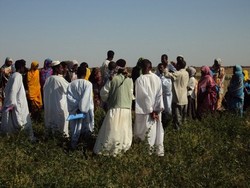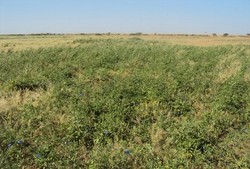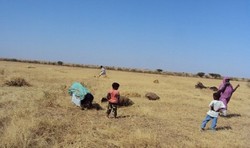Women Grouping Conserving Nature and Improving Livestock Productivity
The Government of Sudan and the International Fund for Agricultural Development (IFAD) have selected the Butana rain fed region located in the Central - Eastern Sudan for the implementation of the Butana Integrated Rural Development Project (BIRDP). The project is financed by IFAD on loan basis and is effective by the end of 2008 .The overall project objectives are to regulate access to rangelands , improve the livelihoods of poor rural households in the target area as well as strengthen communities’ resilience in the face of the recurrent drought. The Butana area hosts approximately 8.2 million heads of livestock and is inhabited by 800, 000 persons.
The project targets smallholder households engaged in rain fed cultivation of sorghum mainly as a food crop and smallholder pastoralists who migrate seasonally with their herds. Livestock production and marketing is the most viable economic activity in the Butana region, and raising livestock productivity is an effective way of creating lasting improvements in living conditions and household food security for the poorest households in the project area. It is also a good way of increasing women’s economic status in the community and home. The project helps female –headed households by small off-farm enterprises as well by small ruminants restocking on revolving fund basis.
Satellite Imagery depicting Butana area with land uses and isohyets.
Butana is the study area which is a flat plain traversed with a series of low mountains, hills and wades. It is located in the centre of the north-eastern part of the Sudan extending roughly between latitudes 14◦ 33 and 16◦22’ North and longitudes 33◦33’ and 35◦33’ East covering an area of approximately 65,000 km2(exactly two and half the size of Rwanda). The rainfall is erratic and fluctuating and varies from 145 to 250 ml per year (mainly between July to September).Also, the area is characterized by high temperature reaching 48 C0 in the dry months and high wind velocity due to lack of tree cover except along wades and depressions .However, these characteristics along the dominance of clay soil have conspired to make poor land productivity particularly in years of rainfall below the normal. The area is almost the site of the BIRDP activities. It falls currently in ten administrative localities within the five states of Gedaref, Gezira, Kassala, Khartoum and River Nile which have share in Butana Land area with biggest part in Gedaref followed by Kassala and both states in Eastern Sudan.
The area is visited by the nomadic and transhumant camel-owning tribes during the rainy season while it is populated by agro-pastoralists/sedentary communities who practice rain-fed agriculture along wades and depressions. Also, historically the farmers are using, on small scale, terraces as a suitable water harvesting structure to offset the low and erratic rainfall pattern. These sedentary communities also combine cultivation in most cases to cope with drought years and mainly cultivate sorghum local variety that has ability to provide straws/stovers as animal feeds both in wet and dry years.
Historically Butana considered as a free disease area and endowed with the most palatable and high nutritive range plants like Blepharis edulis and Carlteria spp (locally known as Siha and Safari respectively). Traditional mode of animal production is the dominant one in which the owners rely on free scavenging /grazing.However, the benefits accrued from livestock sector takes different forms and shapes ranging from selling of live animals and skins i.e. monetized economy to direct food as milk, yoghurt and ghee in subsistence economy Diversity in natural range plants especially existence of the browsing tree species, which provide sustainable and nutritive source of feed throughout the year, is the crucial factor behind this.
The dignitaries of the native administration in Butana, as well as their contemporaries in other parts of the Sudan, they were managed to establish a coherent governance framework for a regulated access to land and water resources of the communal land. This could be exemplified by the ex-presence of the so-called “the communal rangelands and the private rangelands "in Butana. These two types of rangelands were well delineated and recognized to allow maximum benefits for livestock owners from both settlers and outsiders/nomads. However, the increase in livestock population over the past years, the abolition of native administration coupled with the fluctuating rainfall all have conspired to contribute to the severe deterioration of the Butana grazing resources.
Thus, the dwindling in grazing and browsing resources coupled with the entire eroding of the environmental ecosystem has resulted in collapse of the existing economic system particularly for the sedentary people who lost substantial numbers of animals that sustain their dietary requirements. As observed by the project personnel through frequent field visits the animals of settlers are of low production at the dry season and it is easily proved by the frail and emaciated bodies of these animals. Also the situation in Butana became gloomy following the secession of south Sudan. These political changes have resulted in strained relation led to curb the nomadic movement to the rangelands in the south and alternatively these nomads have resorted to Butana with extra pressure from all perspectives. This havoc had and still of apparent negative impact on Butana particularly in the centre where the BIRDP has an implementing unit based in As-Subagh town to cater for developmental concerns and issues mainly at the grassroots level. This town as it is growing large, due to its selection as a capital of a locality and the starting of the mining activities, it's life aspects are adversely affected in general and crop-livestock production base in particular. This situation has encouraged the Locality and the State Department of Range and Pasture in 2006 to construct a fence on 83 hectares using barbed wire and metallic posts in the adjacent environ of As-Subagh town. The main purpose of this fenced land is to protect the town from the repercussion of wind whether tiny dust or propelling soil particles, gully erosion by rain water as well as to act as a demonstration plot to convince and/or make people aware of the environmental degradation and it’s negative impact on production system and the tremendous need for natural resource protection, conservation and restoration. Apart from fence erection no genuine efforts made to obtain these objectives and eventually remarkable portions of the fence were either looted or dismantled leaving the public frustrated and disappointed calling for complete removal of this costly fence.

One year after the inception of the BIRDP, the implementing project unit in As-Subagh has started to look at this fenced land and explore ways for achieving it’s objectives. In fact the unit has started in 2010 by developing and constructing different water harvesting structures inside the fence using tractor –mounted implements like scraper and backhoe without giving attention to repairing and maintaining of the fence itself. Immediately after starting this activity, eight women came in the fence and met with project staff asking about the intended project interventions and the possibility of getting benefit from this fenced land. Actually these women are female –headed households (divorced or widowed) residing in As-Subagh .As they had narrated their situation these women used to cultivate food crop(sorghum)and grow a few small ruminants but currently are completely relied on the later and abandoned the former . As added by them that their cultivable land became degraded and of low fertility due to excessive use of land particularly after the expansion and growth of their home village (As-Subagh) which is almost a semi urban centre . So these women to cultivate land with promising harvest in case of good rain they should go far distant area from their living compounds in As-Subagh which is not of an easy access without having vehicles like saddle animals (donkey) which is unaffordable or very difficult to keep , water and feed it in the dry season. In that meeting with the project personnel the purpose of this fenced land was explained to these women who were pledged to contribute to this purpose as well as to their living earnings by improving their livestock productivity i.e. go hand in hand with the project approach and philosophy.

Women Group explains the initiative/innovation to visitors including some from neighboring states.
Each woman has got a land plot of about one acre inside the fence to produce fodder from native and recently introduced exotic species like Clitoria ternata and Cyamopsis tetragonoloba (cluster bean). The native species including highly palatable ones which are started to disappear and extinct like, due to heavy grazing pressure, Blepharis edulis and Carlteria spp. The project has supported these women by the supply of kick start seed and construction of different long lived/coherent water harvesting structures including terraces/embankments along three sides of the land plot leaving the fourth one (the upper part)to receive and direct the runoff water of the catchment inside the reseeded/planted plots. Each woman is managed to harvest and store dry matter of fodder for animal consumption after the end of the growing season with focus on the critical dry months (March-June). The majority of these women have planted out Clitoria ternata that has recorded a productivity ranging between 2 to 3 tons of dry matter of fodder per one acre from 2 to 3 cuts during October-November.
The vigorous growth of introduced fodder plant (Clitoria ternata) at flowering stage under annual rainfall around 200 mm(locally classified as moderate year i.e.not bad not good).
As these women are adopting cut and carry system of grazing they have gained skills on how to cut, dry and store their produce in appropriate way without losing it’s green colour, natural flavor as well as it’s end nutritive value. They used to put the dry fodder in bundles or pack in plastic bags and place and pile it on safe racks under thatch hut/shed beside the living compound. It is worth to mention that this fenced land beside it’s benefit to this women group from their allocated land plots, it represents the main source of rangeland seed of highly palatable plant species that are required for natural dispersion /reseeding and regeneration inside and outside the fence for the benefit of other rural communities targeted by BIRDP in Butana area .However, with regards to seed collection the BIRDP is relied on this women group against cash payment instead of hiring others.
Three women from the beneficiary group are collecting seed and cutting fodder of natural range plants inside the fenced land.

By realizing a tangible benefit to women, the project has faced difficulty as new women came requesting to join such pioneers group. However, the project has encouraged these new ones to group themselves based on living cluster/hamlet and assign and demarcate land plots close to their settlements to ease protection as well as transfer and replication of these practices. Accordingly, two of these groups agreed and accepted the idea by identifying and allocating land as a range reserve to improve their livestock productivity. Furthermore, the project has urged the pioneer women group to register themselves in a legal entity for better benefit by diversifying activities through getting help from different stakeholders including financial/banking institutions. It is worth to mention that the Locality Commissioner through his keen participation in the field visits of Government-IFAD joint missions to this site , lets him to lead a campaigns for replication and scaling up of this initiative.
The Commissioner of Butana Locality is participating in the field day organized by women group in collaboration with BIRDP staff.
These women to overcome the drudgery and labour demanding task of patrolling have organized themselves in two shifts: the first one from the sun rise up to the noon and from it and up to the sunset /dark is the time for the second shift. Each shift is served by about 8 women. However, to compromise for their social lives particularly to cater for bringing up their youngest children these women are organized the shifts in such way to prevent placing of two neighboring women in one shift i.e. each one assists her neighbor in taking care after children/elders in absence. Also over a short period of time and by having good proceeds from seed collection and the selling of the surplus fodder each woman has got better access to communication through buying of a low priced mobile cell phone. Thus, this mobile phone beside it’s social role also serves protection by maintaining appropriate timing of shifts as well as reducing patrolling effort as the fence is wide and of extended size. Also to enjoy patrolling shit the group is working to give social flavor to this task by transferring the café event to the fenced land through in-kind contribution of each by the essential items like sugar, coffee, hale etc. Usually this event takes place after the breakfast by gathering of neighboring women in the house of the eldest or socially active one and/or in rotating manner to drink coffee in many parts in the Sudan but with special rite in Butana and central and eastern Sudan as a whole.
Amongst this group is the leader Zainab Abu Sin , she is 51 year old and the head of a six member household since her father died when she was 16 year old. She had quitted the school to take care after her family .She is the eldest amongst four sisters in addition to two children who are the sons of her disabled brother. Zainab when was started with BIRDP she has 4 goats only and she always sells the kids when reach six month age to prove food grains and clothes. Actually by the harvesting of planted fodder in the fence she was started feeding these goats to give milk and prepare themselves for gestation and new births. So, after seven months all these goats gave birth to 10 kids (2 of them gave twins and each of the rest gave triplets). In addition to that the lambing rate becomes twice a year instead of one. Also the milk yield of one lactating goat increases from 225 to 675 milliliters per day in the dry months and double this quantity during the growing season .However, the increase in milk has bridged the gap in food as the family relies on it as fresh or after processing it in form of yogurt and ghee. The selling of kids has assisted Zainab and her family to obtain essential utensils and assets like cupboards and beds and also pay school expenses for the sons of the disabled father .These two children is currently enrolled at higher classes in the primary school.
Women by assuming and taking up protection/patrolling exercise in a well organized discipline/manner are getting good image in the eyes of the community who has started to change the their previous idea about the fenced land .This good image is not only in the eyes of ordinary peoples but even in the eyes of those who are famous with frequent intrusion and violations of law and traditions.
Livestock production in fragile environment is a potential source of livelihood and of friendly /rational use of the meager natural resource base particularly in highly populated area in the rain fed sector. Moreover, the recent outcome of research studies in the respective area is the release of 2 drought- tolerant varieties of sorghum (Butana & Bashayer variety). Nevertheless, the great part of Butana area has not benefited of this due to low rains as normally receives less than 250 mm which is the minimum requirement of these two varieties (250-350 mm), where as practical experiences have proved that the native and introduced fodder/range plants like those mentioned above are viable and of sustainable product under the same prevailing circumstances.
In addition to the above, the women grouping and empowering could help in restoring natural resource through adapting social means of protection and technical package that is relevant and affordable.
Protection and rainfall are the prime limiting factors in development and improvement of natural resources and production base in Butana area and therefore any effort /plan from the different stakeholders /actors they should address these issues first as entry points to integrated development .Moreover , all biologically related interventions like seed broadcasting , planting out of seedlings of browsing trees , reseeding ….etc. are ended in vain or in negligible improvement of grazing resources without protection Therefore , the different means of social protection should be tapped and emphasized whether using rotating shifts of patrolling amongst community members and/or community -paid guard as well as water harvesting of potential surface runoff of rain water using an environmentally –appropriate , socially accepted and economically affordable machines.
Best Regards
Mohammed ELhassan Ali
Natural Resource Management (NRM) Officer
Butana Integrated Rural Development Project (BIRDP)
Sudan



ساحة النقاش